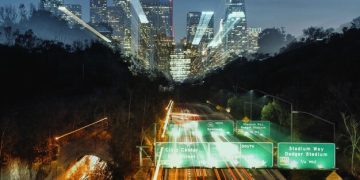The Rise of the Creator Economy: Trends Shaping Our Future

The rise of the creator economy signifies a profound shift in work and consumption, empowering individuals to monetize their passions through digital platforms, thereby reshaping traditional industries and driving new forms of innovation.
In an era defined by rapid digital transformation, a phenomenon has steadily gained momentum, fundamentally altering how we perceive work, content, and commerce: the rise of the creator economy. This burgeoning ecosystem empowers individuals to build businesses around their unique talents and passions, fostering a direct connection with their audience and bypassing traditional gatekeepers.
The Genesis of the Creator Economy: From Niche to Mainstream
The creator economy, at its core, represents a democratization of entrepreneurship. It has evolved from rudimentary blogging and early YouTube channels into a sophisticated network of platforms, tools, and monetization strategies. This evolution isn’t merely technological; it reflects a societal shift towards valuing authenticity, personal connection, and specialized knowledge over mass-produced content. The journey from hobbyist to professional creator showcases a powerful narrative of self-determination.
The early stages were characterized by individuals venturing into uncharted digital territory, often driven by passion rather than profit. They built communities organically, finding resonance with audiences who sought voices beyond traditional media outlets. This organic growth laid the groundwork for what would become a multi-billion-dollar industry, attracting significant investment and innovation.
Pioneering Platforms and Early Adopters
The emergence of platforms like YouTube, Instagram, and later TikTok provided the infrastructure necessary for creators to reach a global audience. These platforms offered user-friendly interfaces and monetization avenues, albeit often limited, that incentivized content creation. Early adopters, often visionaries, carved out new niches and demonstrated the viability of making a living as a digital content producer. Their success stories inspired a new generation.
- YouTube: The original long-form video hub, enabling creators to build deep communities.
- Instagram: Transformed visual content creation into a powerful marketing tool.
- Blogging Platforms: Provided a space for written thought leadership and niche communities.
- Podcasting: Revitalized audio storytelling, offering intimate and flexible content consumption.
From Passion Project to Professional Pursuit
As the audience grew and engagement metrics became quantifiable, the concept of “influence” began to emerge. Brands recognized the power of these individual creators to connect with highly engaged audiences, leading to the infusion of advertising dollars and sponsored content. This commercial validation transformed hobbies into viable career paths, attracting talent from various backgrounds and pushing the boundaries of what “work” could entail. The professionalization brought with it new expectations for content quality, consistency, and business acumen.
The early days were often marked by trial and error, a learning curve for both creators and platforms. However, this experimental phase fostered a culture of innovation that continues to define the creator economy. It proved that expertise isn’t confined to traditional institutions and that value can be generated in countless new ways.
Technological Catalysts: Fueling the Creator Economy’s Expansion
The rapid acceleration of the creator economy is inextricably linked to technological advancements. Beyond core social media platforms, a sophisticated ecosystem of tools and innovations has emerged, empowering creators with capabilities previously available only to large media companies. These technologies address everything from content production and distribution to audience engagement and direct monetization.
Artificial intelligence (AI) is playing an increasingly pivotal role, enhancing creator capabilities in numerous ways. From automating video editing tasks to generating content ideas and personalizing audience experiences, AI tools are streamlining workflows and enabling creators to focus more on their core creative output. This efficiency frees up time that would otherwise be spent on mundane or repetitive tasks, allowing for greater creative exploration. AI-driven analytics also provide deeper insights into audience behavior, helping creators tailor their content more effectively.
The Rise of AI in Content Creation
AI-powered tools are revolutionizing various aspects of content creation, making high-quality production accessible to a broader range of creators. Image and text generation AI, for instance, can assist in brainstorming, scriptwriting, and even creating visual assets, significantly reducing the barrier to entry for aspiring creators. Video editing software integrated with AI can automatically cut, color correct, and add effects, thus professionalizing content without requiring extensive technical skills or expensive equipment.
- AI-driven Content Generation: Tools that can draft articles, social media posts, or even basic video scripts.
- Automated Editing: AI algorithms that streamline video and audio post-production processes.
- Personalized Recommendations: AI behind platforms suggests content to viewers, increasing discoverability.
- Analytics and Insights: AI processes data to reveal audience preferences and engagement patterns.
Web3 and Decentralization: A New Frontier
The emergence of Web3 technologies, particularly blockchain and NFTs (Non-Fungible Tokens), promises to further decentralize the creator economy. NFTs offer creators new avenues for monetization, allowing them to sell unique digital assets directly to fans, bypassing traditional intermediaries. This creates new revenue streams and enhances fan engagement by offering exclusive access or ownership. Blockchain technology also facilitates greater transparency and security in transactions, ensuring creators have more control over their intellectual property and earnings.
The move towards decentralized platforms could shift power dynamics, giving creators more control over their content, data, and direct relationships with their audience. This paradigm would reduce reliance on centralized social media platforms, potentially leading to more equitable revenue sharing and less susceptibility to algorithmic changes. While still in its early stages, Web3 holds the potential to significantly reshape the economic landscape for creators.
Diversification of Monetization: Beyond Traditional Ads
One of the most significant indicators of the creator economy’s maturity is the diversification of its monetization models. While advertising revenue was once the primary source of income for many creators, a rich tapestry of strategies has emerged, offering more stable and direct pathways to financial sustainability. This shift reflects a deeper understanding of audience value and a move towards more direct fan-to-creator support.
Subscription models have become particularly prevalent, allowing creators to build recurring revenue streams by offering exclusive content, early access, or community perks. Platforms like Patreon and Substack exemplify this trend, empowering creators across various mediums – from podcasters and writers to artists and educators – to operate thriving subscriber-based businesses. This model fosters a deeper connection with the most dedicated fans, who are willing to pay for premium experiences.
Subscription Models and Direct Fan Support
Direct fan support mechanisms empower audiences to financially contribute to creators they value, going beyond free consumption. This includes paid memberships, recurring subscriptions, and one-time donations. This shift is crucial because it aligns creator incentives directly with adding value for their most loyal followers, rather than solely chasing advertising impressions.
This model often creates stronger communities around creators, offering fans a sense of belonging and direct access. It allows creators to be less reliant on unpredictable ad revenues or platform algorithms, providing a more stable and predictable income stream. Furthermore, it encourages creators to produce content that truly resonates with their core audience, rather than pandering to mass appeal.
- Patreon: A leading platform for recurring fan subscriptions.
- Substack: Facilitates paid newsletters and independent journalism.
- YouTube Memberships: Offers exclusive content and badges for paying subscribers.
- Twitch Subscriptions and Bits: Provides various ways for viewers to support streamers.
Brand Partnerships and E-commerce Ventures
Beyond direct audience support, strategic brand partnerships remain a cornerstone of creator monetization. These collaborations range from sponsored content and product placements to ambassadorships and co-created campaigns. Brands increasingly recognize the authenticity and specific reach of creators, valuing their ability to connect with niche audiences in a genuine way. Moreover, many creators are now leveraging their audience and personal brand to launch their own product lines or e-commerce stores, converting influence into tangible businesses. This entrepreneurial spirit signifies a move from being merely content producers to full-fledged business owners.

The diversification of income streams provides creators with greater resilience and financial stability, insulating them from the volatility of any single platform or revenue source. It also encourages a multifaceted approach to content creation and community building, leading to more innovative and sustainable ventures.
Impact on Traditional Industries: Reshaping Media and Marketing
The rise of the creator economy is sending ripples through established media and marketing landscapes, forcing traditional players to adapt or risk obsolescence. The shift in audience attention from mainstream channels to individual creators has fractured traditional advertising models and redefined what constitutes “media.” Legacy media companies are now grappling with how to compete with the agility, authenticity, and direct audience connection offered by creators.
The advertising industry, in particular, has undergone a seismic shift. Brands are reallocating significant portions of their marketing budgets from traditional media buys to influencer marketing, recognizing the higher engagement rates and trust that creators command with their audiences. This trend highlights the power of authenticity and niche targeting, realms where creators excel. It necessitates a more nuanced approach from advertisers, focusing on genuine partnerships rather than just broad reach.
Disrupting Traditional Media Outlets
Traditional media outlets, from television networks to print publications, face unprecedented competition for audience attention. Viewers and readers are increasingly turning to creators for news, entertainment, and specialized information, often preferring the unfiltered, personal perspective. This has led some traditional outlets to acquire creator-led ventures or launch their own creator programs, attempting to recapture fragmented audiences. The emphasis has shifted from mass appeal to highly targeted, community-driven content.
The ability of individual creators to produce and distribute high-quality content with minimal overhead challenges the capital-intensive nature of traditional media. This disruption fosters innovation, pushing established players to experiment with new formats, platforms, and audience engagement strategies.
- Loss of Audience: Viewers and readers migrating to creator-led platforms.
- Advertising Shifts: Budgets moving from traditional channels to influencer marketing.
- Content Formats: Emphasis on short-form video and live streaming over traditional broadcast.
- Talent Drain: Media professionals leaving legacy institutions for creator careers.
Evolution of Marketing and Advertising Strategies
The marketing industry has pivoted dramatically to integrate creators into its campaigns. Influencer marketing agencies have proliferated, connecting brands with creators whose audiences align with their target demographics. This shift goes beyond simple product endorsements; it involves co-creation of content, long-term brand ambassadorships, and integrated campaigns that leverage the creator’s unique voice and community trust. The effectiveness often lies in the authenticity of the creator’s recommendation.
Furthermore, the detailed analytics available through digital platforms allow brands to measure the direct ROI of creator campaigns more accurately than traditional advertising. This data-driven approach is further accelerating the shift of marketing spend towards the creator economy, recognizing its measurable impact on consumer behavior and brand perception.
The Creator as a Small Business: Challenges and Opportunities
As the creator economy matures, the narrative shifts from individual hobbyists to recognizing creators as true small business owners. This paradigm brings with it both immense opportunities for entrepreneurial freedom and significant challenges, ranging from financial precarity to the demands of self-management. Creators are essentially startups, responsible for everything from content production and marketing to customer service and financial management.
The opportunity lies in unprecedented autonomy and direct control over one’s work and brand. Creators can pursue their passions, build niche communities, and directly monetize their unique skills without traditional employment constraints. This entrepreneurial freedom is a powerful draw, inspiring millions to try their hand at becoming full-time creators. However, this freedom comes with significant responsibilities and often a steep learning curve in various business domains.
Navigating Business Operations and Sustainability
Many creators, initially driven by artistic or communication skills, find themselves ill-equipped for the complexities of running a business. This includes managing finances, understanding legal obligations (like intellectual property and contracts), handling taxes, and continually devising new content strategies. The erratic nature of algorithm changes, advertising revenue fluctuations, and evolving audience tastes also pose significant challenges to long-term sustainability. Building a consistent income stream often requires diversifying monetization and constantly adapting.
The psychological toll of being a sole proprietor, often working in isolation, also cannot be understated. Burnout is a common issue due to the constant pressure to produce content, engage with audiences, and stay relevant in a competitive landscape. Mental health support and business education are becoming increasingly important for creators to thrive.
- Financial Management: Budgeting, invoicing, tax planning for variable income.
- Legal Compliance: Understanding contracts, intellectual property, disclosures.
- Content Strategy: Adapting to trends, maintaining relevance and quality.
- Burnout Prevention: Managing workload, setting boundaries, mental well-being.
Building Community and Brand Loyalty
At the heart of a successful creator business is a strong, engaged community. This involves more than just accumulating followers; it means fostering genuine connections, responding to feedback, and creating a sense of belonging among the audience. This loyal community is not only a source of direct support but also acts as a powerful marketing engine through word-of-mouth and organic sharing. Building this loyalty takes consistent effort, authentic engagement, and a deep understanding of the audience’s needs and desires.

The creator’s personal brand is their most valuable asset. It encompasses their unique voice, values, and the consistent quality of their output. Nurturing this brand requires authenticity, transparent communication, and a willingness to evolve while staying true to one’s core identity. It is this personal brand that ultimately differentiates a creator in a crowded digital space.
The Ethical Landscape: Responsibility and Regulation in the Creator Economy
As the creator economy continues its exponential growth, so too does the need for a robust ethical framework and responsible regulatory oversight. The sheer scale and influence of creators raise critical questions about transparency, consumer protection, data privacy, and the broader societal impact of their content. Without clear guidelines, the potential for misinformation, exploitation, and unethically produced content looms large, posing risks to both audiences and the creators themselves.
Key concerns include the clear disclosure of sponsored content, ensuring that advertising is not disguised as organic recommendations. Furthermore, the mental health implications for both creators and their often young audiences, grappling with online pressures and curated realities, are increasingly a subject of public discourse. Platforms and regulatory bodies are beginning to acknowledge these issues, but the pace of technological change often outstrips the ability to implement effective safeguards.
Transparency and Disclosure Guidelines
One of the most pressing ethical concerns revolves around transparency, particularly regarding sponsored content and paid partnerships. Audiences deserve to know when a creator is being compensated for their endorsement. Regulatory bodies in various countries, such as the FTC in the US, have issued guidelines requiring clear and conspicuous disclosure of commercial relationships. However, enforcement remains a challenge, and innovative methods of subtle product placement continuously emerge.
Creators themselves bear a significant responsibility to be transparent with their audience, fostering trust through open communication about their financial dealings. This ethical stance is not just about compliance; it’s about maintaining credibility and long-term audience loyalty. The lack of clear disclosure can erode trust, leading to backlash and damage to a creator’s brand.
- FTC Guidelines: Mandates clear disclosure for sponsored content in the US.
- Influencer Marketing Associations: Provide best practices and ethical codes.
- Platform Policies: Varying degrees of enforcement regarding sponsored posts.
- Audience Expectations: Growing demand for authenticity and honesty from creators.
Addressing Misinformation and Creator Accountability
The decentralized nature of the creator economy, while empowering, also presents challenges in controlling the spread of misinformation and harmful content. With vast reach, individual creators can inadvertently or intentionally propagate false narratives, impacting public opinion and even health. Platforms are under increasing pressure to moderate content effectively, but the sheer volume makes this a complex task.
Beyond platforms, there’s a growing discussion about individual creator accountability. What responsibility do creators have for the accuracy of the information they share, especially in sensitive areas like health, finance, or politics? This question is central to maintaining a trustworthy digital ecosystem and distinguishing credible voices from those that might cause harm.
The Future Trajectory: What’s Next for the Creator Economy?
The creator economy is not a static phenomenon; it is a dynamic and ever-evolving landscape. Looking ahead, several key trends are poised to shape its future trajectory, influencing everything from technology and monetization to community building and the relationship between creators and their audiences. Continued innovation, particularly in immersive technologies, will likely open up entirely new dimensions for creative expression and audience engagement.
We can anticipate a further blurring of lines between creators and traditional businesses, with more creators launching fully-fledged companies, complete with employees and comprehensive product lines. The focus will likely shift even more towards hyper-niche communities and highly personalized content experiences, moving away from broad, mass-market approaches. The quest for unique, authentic engagement will continue to drive innovation.
Immersive Experiences and the Metaverse
The development of the metaverse and immersive technologies like virtual reality (VR) and augmented reality (AR) presents a groundbreaking frontier for creators. Imagine virtual concerts, interactive educational experiences, or personalized shopping in digital storefronts built by creators. These technologies promise to offer unprecedented levels of engagement and new avenues for monetization, allowing creators to build and operate entirely new forms of digital worlds and experiences.
This shift could lead to a new generation of “experience creators” who specialize in designing interactive and immersive content, going far beyond traditional video or audio formats. The metaverse represents a vast new canvas for artistic expression and community building, potentially redefining the very nature of content consumption.
- Virtual Concerts: Artists performing in virtual spaces for global audiences.
- Interactive Education: Learning environments built within VR/AR platforms.
- Digital Art and Fashion: Creation and sale of virtual goods and experiences.
- Social Spaces: Creators building bespoke virtual communities.
Deepening Creator-Audience Connections and Micro-Communities
The future of the creator economy will likely see an increased emphasis on fostering deeper, more intimate connections within micro-communities. As the digital landscape becomes more crowded, creators will differentiate themselves not just by the content they produce but by the strength and exclusivity of the communities they build. This could involve more private forums, exclusive live events, or highly personalized content delivery.
The focus will shift from simply accumulating large numbers of followers to cultivating highly engaged, loyal members who feel a genuine sense of belonging and direct access to the creator. This trend will reinforce the value of authenticity and reciprocity, strengthening the bond between creators and their most dedicated fans, ultimately leading to more sustainable and meaningful creator careers.
| Key Trend | Brief Description |
|---|---|
| 🚀 Empowered Individuals | Individuals monetize passions through platforms. |
| 💡 Tech Advancement | AI, Web3, and immersive tech fuel growth. |
| 💰 Diverse Monetization | Subscriptions, brands, and e-commerce models. |
| 🌐 Industry Shift | Reshaping media, marketing, and employment. |
Frequently Asked Questions about the Creator Economy
The creator economy is an ecosystem where individuals, known as creators, use digital platforms to monetize their skills, passions, and unique content directly to their audience. It encompasses various forms of content, including videos, written articles, music, art, and more, allowing creators to build personal brands and independent businesses.
Creators utilize diverse monetization strategies. Common methods include advertising revenue from platforms (e.g., YouTube ads), direct audience support through subscriptions (Patreon, Substack), brand sponsorships and partnerships, merchandise sales, digital product creation (e-books, online courses), and consulting services. This multi-pronged approach helps ensure financial stability.
AI increasingly assists creators by automating labor-intensive tasks like video editing, generating content ideas, enhancing personalization for audiences, and providing advanced analytics. This allows creators to streamline their workflows, improve content quality, and allocate more time to their core creative processes, making high-quality production more accessible.
The creator economy is significantly disrupting traditional media and marketing by shifting audience attention and advertising budgets. Traditional outlets are adapting by integrating influencer marketing and exploring creator-led content, while brands are increasingly prioritizing authentic partnerships with creators for targeted reach and higher engagement than traditional advertising channels.
Creators face challenges such as financial instability due to fluctuating incomes, the constant pressure to produce engaging content, avoiding burnout, navigating complex business operations (like taxes and legalities), and adapting to evolving platform algorithms. Ethical considerations, including transparency and combating misinformation, also pose significant hurdles for creators and platforms alike.
Conclusion: The Enduring Power of the Individual
The rise of the creator economy is not merely a transient trend but a foundational shift in how value is created, distributed, and consumed in the digital age. It champions the power of the individual, transforming passions into viable professions and fostering direct, authentic connections between creators and their audiences. While challenges remain, from navigating business complexities to addressing ethical responsibilities, the continued evolution of technology, combined with a growing societal appreciation for genuine content, suggests a future where individual creativity and entrepreneurial spirit will flourish, continually reshaping our economic and cultural landscapes.





